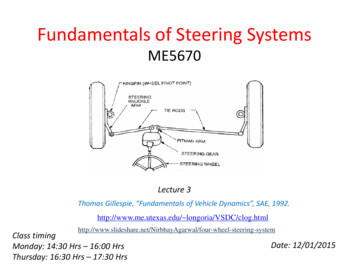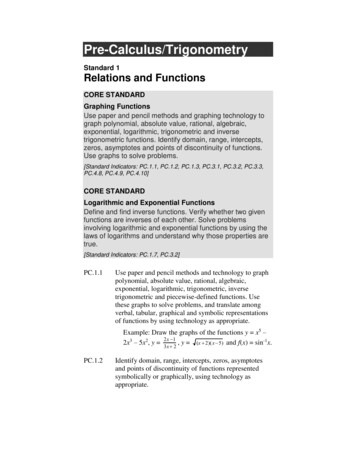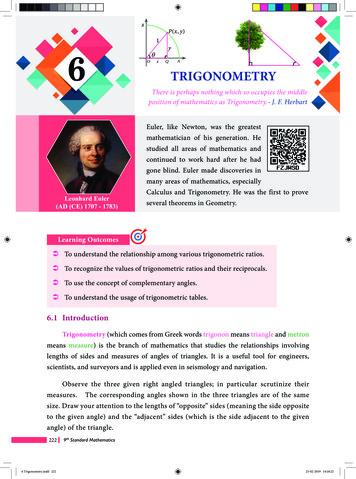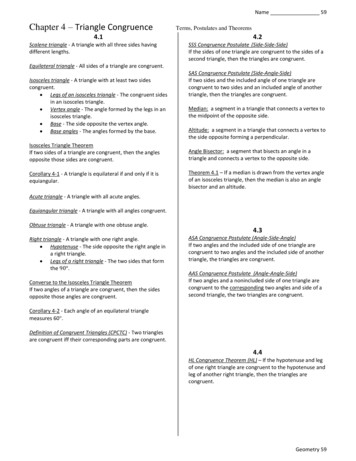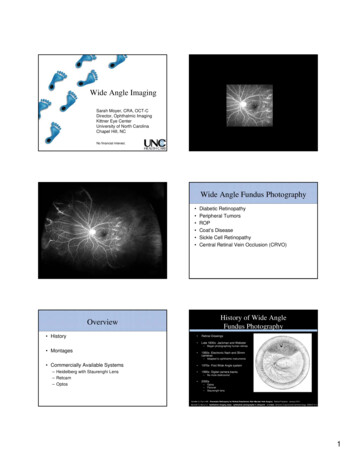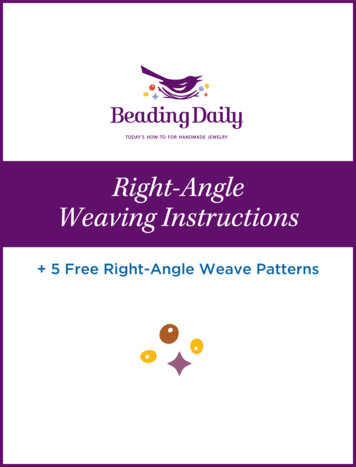
Transcription
Right-AngleWeaving Instructions 5 Free Right-Angle Weave Patterns
Right-Angle Weaving Instructions 5 Free Right-Angle Weave PatternsSingle-needle right-angle weaveroyal chains lariatvintage charmby jean campbell p. 1by Kelly wiese p. 3by amy haftkowycz p 6Contentscrazy for coppermagic carpet braceletsby shelley nybakke p. 9by margo field p. 11diamond of pearlscabochon bezelby trang gordon p. 14by jennifer vanBenschoten p. 17ii
Right-Angle Weaving Instructions 5 Free Right-Angle Weave PatternsDo you love working with right-angle weave? This superheroof bead-weaving stitches can do just about anything with anykind of beads that you have handy. When I want to bead justfor beading’s sake, I’ll grab two or three colors of seed beadsand start working in right-angle weave.For those of us who love to embellish the surface of our beadweaving with fringe and accent beads, right-angle weave providesthe perfect base for us to let our imaginations run wild.The thread path of right-angle weave is unique in that it goes inlittle circles as you work across each row or around in a tube. It’sthis thread path that makes right-angle weave such a strong andflexible bead-weaving stitch – you can even use it to create a rightangle weave beaded “fabric” that can be folded and stitched.If you’ve never worked right-angle weave before, get an easylesson in single-needle right-angle weave from none otherthan Jean Campbell in her Stitch Pro column from the pages ofBeadwork magazine. Jean takes the guesswork out of rightangle weave with her clearly illustrated instructions.Once you’ve mastered the basics, put them to use with oneof these five free right-angle weave beading patterns: While Margo C. Field’s Magic Carpet Bracelets may seemsimple, the use of three different sizes of seed beads is kind oflike a little right-angle weave test. By the time you’ve finishedyour bracelet, you’ll not only have a great understanding ofthe right-angle weave thread path, you’ll also know a little bitmore about how to pull off a successful color gradation! Even though Shelley Nybakke’s Crazy for Copper necklaceonly uses one base row of right-angle weave, it’s a great wayto practice that thread path. Bonus: you’ll have a gorgeouscopper and crystal beaded necklace when you’re finished! Right-angle weave also makes beautiful and easy beaded beads.Learn how to make self-supporting right-angle weave beadedbeads when you make Amy Haftkowycz’s Vintage Charm bracelet. Mixing the beaded beads with beaded dangles on a brasschain makes a beaded bracelet with a distinctive Victorian flair. The thread path of right-angle weave also makes it perfectfor securing multiple components in a beading project.Kelly Wiese’s Royal Chains Lariat takes a few strands ofchevron stitch and joins them together using right-angleweave for a beautiful and sturdy beaded necklace. Now, if you’re ready for a challenge, pick up two beading needles and make Trang Gordon’s Diamond of Pearls Pendant.Use your favorite colors of sparking crystal beads, pearls, andseed beads to create this double layered pendant using twoneedle right-angle weave! And finally, follow my step-by-step instructions to learn howto make a bezel using right-angle weave and peyote stitch! Aright-angle weave bezel for a cabochon is easy to do, secure,and opens up a world of possibilities for embellishing.Take a break from the ordinary and refine your beadstitching skills with these fantastic right-angle weave beading patterns. Layer it, shape it, embellish it – whatever you dowith right-angle weave, you’ll be one happy beader when you’refinished. When you find yourself in a bead-weaving emergency,call on right-angle weave, the superhero of bead-weavingstitches, to save the day!Jennifer VanBenschoten, Beading Daily editorRight-Angle Weaving Instructions 5 Free Right-Angle Weave Patternseditor, beadingdaily JENNIFER VANBENSCHOTENphotography JOE COCA, ANN SWANSONProjects and information are for inspiration and personal use only. BeadingDaily, Beadwork, and Stringing do not recommend, approve, or endorse any of the advertisers, products, services, orviews advertised in this publication. Nor do BeadingDaily, Beadwork, or Stringing evaluate the advertisers’ claims in any way. You should, therefore, use your own judgment in evaluating theadvertisers, products, services, and views advertised in BeadingDaily, Beadwork, and Stringing.Introductioniii
Stitch ProSingle-Needle Right-Angle Weavejean campbellThis stitch, which creates a supple,strong fabric of beads, is done byweaving beads in a figure-eightpattern. The beads that create eachstitch or “unit” all sit at right anglesto one another, thus the name! Wantto go one step beyond? Stitch up acouple of right-angle-weave squares,stack them, and stitch the sidestogether to form a faux cubic rightangle-weave component you can useas a charm, link, or earring dangle.For this lesson, all you need is twodifferent colors of size 11 seed beads(A and B), a beading needle, andsome thread to follow along.technique right-angle weaveproject levelRow 1, Unit 1: String 4A and tie them intoa tight circle; pass through the first 2Astrung to clear the knot. This is the firstright-angle-weave unit (Photo 1).Row 1, Unit 2: String 3A; pass through thelast A exited in the previous unit (Photo 2),and the first 2A just strung (Photo 3). Snugthe beads to finish the unit (Photo 4).Row 1, Units 3–5: Repeat Unit 2 threetimes to form a strip 5 units long. Thethread path will resemble a figureeight, alternating directions with eachunit. Turn the strip so it sits horizontally on the work surface. Exit throughthe top bead of the final unit towardthe beadwork (Photo 5).Row 2, Unit 1: String 3A; pass counterclockwise through the last A exited inthe previous row and the first A juststrung (Photo 6).123456More wonderful beadwork projects are available at shop.beadingdaily.com/jewelryprojects 2012 Interweave Press LLC. Not to be reprinted. All rights reserved.page 1
89Photos by Jean Campbell710Artist’s Tips1112 U se as tight a tension as possible,especially for the first row. Once you have right-angle weavedown, it helps to use doubledthread to fill the beads quickly,stiffening the fabric. Use a beading awl to poke eachunit into shape.13Row 2, Unit 2: String 2A; pass clockwisethrough the top A of the next unit inthe previous row (Photo 7), the last Aexited in the previous unit (Photo 8),the 2A just strung, and clockwisethrough the top A of the following unitin the previous row (Photo 9).Row 2, Unit 3: String 2A; pass counter-clockwise through the last A exited inthe previous unit (Photo 10), the lasttop A exited in the previous row(Photo 11), and the first A just strung(Photo 12).Row 2, Units 4 and 5: Repeat Units 2 and 3.Rows 3– 5: Repeat Row 2 ( Photo 13 ).Secure the thread and trim.Jean Campbell is a jewelry-design artist, teacher,writer, and author of the book Steampunk-Style Jewelry (Creative Publishing International, 2010). Findout more about what’s on Jean’s mind on beadingwdaily.com and on her website, www.jeancampbellink.com.Layered Right-Angle WeaveWhat Would Happen If?Are you already a right-angle-weave pro?Love everything about it? How about cubic rightangle weave? Or maybe you’re like me and like todo things a little quicker. If so, why not try stitching two identically shaped pieces of right-angleweave together, then working right-angle weavealong the sides (Fig. 1 and Photos a, b, and c) tomake it just look like cubicright-angle weave? Whenthe strong internal threadstructure of cubic rightangle weave isn’t absolutely required for a piece,this technique can be agreat alternative. Pass a jump ring through thecorner unit and you’ve got an instant pendant orcharm.Fig. 1abcMore wonderful beadwork projects are available at shop.beadingdaily.com/jewelryprojects 2012 Interweave Press LLC. Not to be reprinted. All rights reserved.page 2
Royal Chains Lariatk e l ly wi e s eThis graceful lariat is made bycombining two simple chaintechniques with right-angle weaveand square and peyote stitches.The fringe adds just the rightamount of flair.Materials10 g bronze iris size 15 Japaneseseed beads (A)3 g metallic gold size 15 Japaneseseed beads (B)9 g gold-lined clear size 11 Japanese seed beads (C)12 g cobalt iris size 11 Japaneseseed beads (D)20 amethyst 3mm crystal bicones3 amethyst 4mm crystal bicones133 bright gold 3mm crystal pearls2 jet AB 6 10mm vertically drilledpressed-glass drops3 jet AB 6 16mm vertically drilledpressed-glass dropsTan size D nylon beading threadtools2 size 12 beading needlesScissorstechnique chevron chain fringe St. Petersburg chain square stitch right-angle weave circular peyote stitchFinished Size30"More wonderful beadwork projects are available at shop.beadingdaily.com/jewelryprojects 2012 Interweave Press LLC. Not to be reprinted. All rights reserved.page 3
Unit 3 and on: String 1A, 1C,and 4A; pass back throughthe third 1A added in the previous unit (Fig. 2). Repeat toform a 28" long chain.Fringe: String 4A, 1 pearl, one4mm bicone, 1 pearl, one6 16mm drop, one 3mmFig. 1: WorkingFig. 2: Adding Unitbicone, and 4C; pass backUnits 1 and 2 of the3 of the chevronthrough the fourth-to-last Cchevron chainchainjust strung and the next 6beads to exit the fourth A justst r u n g . S t r i n g 3 A ; p a ssthrough the 4A at the end of the chain1) Chevron chain. Use 5' of threadand A and C to weave a chevron chain:(Fig. 3). Repeat the thread path to reinUnit 1: Leaving a 12" tail, string 8A andforce. Secure and trim the working1C. Tie a knot to form a circle and passthread; don’t cut the tail thread. Set thethrough the first 4A.chevron chain aside.Unit 2: String 1A, 1C, and 4A; skip 2A inUnit 1 and pass through the next 1A 2) St. Petersburg chain. Use 5'of thread and C and D to weave a St.(Fig. 1).Petersburg chain:Unit 1: Leaving a 12" tail, string 4D; passthrough the first and second D. String1C and pass through the third andfourth D (Fig. 4).Unit 2 and on: String 4D; pass throughthe first and second D just strung.Make sure the beads are snug againstthe beads of the previous unit. String1C and pass back through the first andsecond D just strung and the nearest1D of the previous unit (Fig. 5). String1C and pass back through the fourthand third D just strung (Fig. 6). Repeatto form a 25½" chain.Fringe: String 3D, then repeat the fringefrom Step 1. Secure and trim the working thread; don’t cut the tail thread.Fig. 3: Working thefringe at the end ofthe chevron chainFig. 4: Working Unit1 of the St. Petersburg chainFig. 5: Starting Unit2 of the St. Petersburg chainFig. 6: Completing Unit 2 of the St.Petersburg chainMore wonderful beadwork projects are available at shop.beadingdaily.com/jewelryprojects 2012 Interweave Press LLC. Not to be reprinted. All rights reserved.page 4
Starting unit: Place a needle on the tailin each stitch and weaving through thechains’ end beads to make the turnaround; repeat to form a fourth round(Fig. 9). Secure the thread and trim.thread. String 1D and 1C; pass backthrough the first and second D addedin this step to complete Unit 1. Set theSt. Petersburg chain aside.4) Additional fringe. Work 2more fringes between the chains:Fig. 7: Square-stitching thechains and adding pearlsKelly Wiese loves to work with size 15 seed beadsand crystals. She travels occasionally to teach herdesigns. She has an online store specializing in herbead kits at www.beadparlor.com.iatdel3) Assembly. Start a new 5' threadthat exits the last C added in Step 2 atthe start of the St. Petersburg chain.Align the first ends of the two chainsso they sit side by side. Position the St.Petersburg chain so its less-uniformedge touches an edge of the chevronchain. Connect the two chains withsquare stitch and pearls:Pearls: Square-stitch the last 1C exited tothe end 1C on the chevron chain.String 1 pearl; pass through the next1C at the edge of the chevron chain(Fig. 7 ). Repeat to add a total of 104pearls; end by square-stitching 2C.Secure the working thread but do nottrim.Spine: Start a new 3' thread that exitsfrom the first pearl added in this step,toward the beadwork. String 1D andpass through the next pearl ( Fig. 8);repeat to connect all of the pearls.Fringe: Exiting the last pearl, string {1Dand 1 pearl} twenty-two times. String1D, one 6 10mm drop, one 3mmbicone, and 4C; pass back through thefirst C just strung and the remainingfringe beads. Secure the workingthread and trim.Straight fringe: Place the needle on thethread left in Step 3. String {1D, 3C, 1D,and one 3mm bicone} fifteen times.String 1D, 1 pearl, one 6 10mm drop,one 3mm bicone, and 4C. Pass backthrough the fourth-to-last C and theremaining beads strung in this step.Exit from the end of the chains, from 1Cnext to where this fringe is attached.Right-angle-weave fringe: Work a strip ofright-angle weave 42 units long with1B as the sides and 3B for the tops andbottoms of each unit. Repeat the fringefor Step 1, omitting the first 4A. Securethe thread and trim.5) Clasp. Weave the St. Petersburgchain’s tail thread through beads toexit the second bead added in Step 2.String 27D; pass through the end 1A ofthe chevron chain. Work circular peyotestitch off the 27D just added, using 1DFig. 8: Adding seed beadsbetween the pearls to create thespineResourcesCheck your local bead shop orcontact: Kits including Nymo nylonbeading thread and Swarovski crystal pearls: Kelly Wiese, beadparlor@yahoo.com, www.beadparlor.com.Artist’s Tips The chain sectionsand fringe can bemade longer orshorter, dependingon your preference. T he lariat can beworn with the loopup tight againstthe neck such asa choker or loosersuch as a moretraditional lariat.Fig. 9: Peyote-stitching the claspMore wonderful beadwork projects are available at shop.beadingdaily.com/jewelryprojects 2012 Interweave Press LLC. Not to be reprinted. All rights reserved.page 5
Vintage Charma m y h aft k o w y c zMaterials2 g silver-lined amethyst size 15 Japanese seed beads (A)2 g silver-lined pale gold size 11 Japanese seed beads (B)2 g silver-lined amber size 8 Japaneseseed beads (C)24 total assorted 3mm crystal biconesin natural colors, including at least 6olivine and 4 topaz17 total assorted 4mm crystal bicones,including topaz, topaz AB, erinite,olivine, light peach, and light Siamsatin22 total assorted 3mm fire-polishedrounds in natural colors, including 8transparent olivine AB and at least 4each of mottled opaque mauve, lighttopaz AB, and transparent indigo AB28 total assorted 4mm fire-polishedrounds in natural colors, includingat least 4 each of transparent indigoAB, topaz, transparent olivine AB,mottled opaque tan, and mottledopaque mauvetoolsScissorsSize 10 or 12 beading needleRound-nose pliersChain-nose pliersWire cutterstechnique right-angle weave netting wireworking4 olivine AB 6mm fire-polished rounds2 light blue 8 6mm fire-polishedrondelles6 natural brass 3mm melon rounds5 natural brass 5mm dimpled rounds8 natural brass 8 12mm filigree flatdrop charms2 natural brass 14 18mm leaf charms4 natural brass 6 2–3mm assortedbead caps2 natural brass 9 5mm 5-petaldecorative bead caps1 natural brass 17mm decorativetoggle ring1 natural brass 5 30mm decorativetoggle bar34 natural brass 2" head pins16 natural brass 7mm 18-gauge jumprings65 8" of natural brass 4–5 5–10mm (29links) long-and-short oval chainSmoke 6 lb braided beading threadGracefully combine right-angleweave beaded beads with brassfindings, beads, and chain tomake a captivating neo-Victoriancharm bracelet.Finished Size7½"More wonderful beadwork projects are available at shop.beadingdaily.com/jewelryprojects 2012 Interweave Press LLC. Not to be reprinted. All rights reserved.page 6
Fig. 1: Right-angle-weavebaseFig. 2: Connectingthe ends of the base1) Beaded beads. Use netting andright-angle weave to make BeadedBead 1 with seed beads and fire-polished rounds:Base: Use 3' of thread to string 1 indigo4mm round, 1C, 1 indigo 4mm round,and 1C, leaving a 6" tail. If desired, passthrough all beads again, tie two overhand knots to form a tight circle, andexit the first bead strung. String 1C, 1indigo 4mm round, and 1C and passthrough the last 4mm round exitedand the first 2 beads just strung; repeatto form a strip of right-angle weave 3units long (Fig. 1).Fig. 4: Adding morenetsFold the beadwork in half. String 1Cand pass up through the 4mm round atthe end of the first unit. String 1C; passdown through the 4mm round at theend of the third unit to form a ring andcomplete the fourth unit (Fig. 2).Netting: String 2A, 1 mauve 3mm round,and 2A; pass down through the last4mm round exited and the first 3 beadsjust strung ( Fig. 3 ). String 2A; passdown through the next 4mm round onthe base. String 2A; pass up throughthe first 3mm round added in this step.Weave through the beads to exit downthrough the next 4mm round on thebase (Fig. 4). Repeat around to embellish every base unit in the same manner.Finishing: Weave through beads to exitfrom 1C at the top of the base. String1B and pass through the next C at thetop of the base; repeat around the topof the base, pulling very tight (Fig. 5).Pass through the beads again to reinforce. Finish the bottom of the base inthe same manner. Secure the threadand trim.Repeat entire step four timesfor a total of 5 beaded beads usingthe following colored beads in place2) Clasp. Use 1 head pin to string 1Cand the toggle bar; form a simple loop.Use 1 jump ring to attach the simpleloop to 1 link at one end of the chain(this will hereafter be called Link 1).Use 1 jump ring to attach the clasp ringto the other end of the chain.3) Finishing. Make a variety ofdangles to add to the chain:Beaded-bead dangles: Use 1 head pin tostring 1 olivine 3mm bicone, BeadedBead 2, and 1 olivine 3mm bicone; formetailMore wonderful beadwork projects are available at shop.beadingdaily.com/jewelryprojects 2012 Interweave Press LLC. Not to be reprinted. All rights reserved.page 7Fig. 5: Finishing thetop of the beadof the mauve 3mm and indigo 4mmand rounds: olivine 3mm and topaz4mm rounds for Beaded Bead 2; lighttopaz 3mm and olivine 4mm roundsfor Beaded Bead 3; indigo 3mm and tan4mm rounds for Beaded Bead 4; andolivine 3mm and mauve 4mm roundsfor Beaded Bead 5.dArtist’s Tip Assembling andattaching the jumpring dangles is themost liberating partof this project—you can add theelements with recklessabandon! Attachdangles to both sidesof the chain; this willresult in wonderfulvisual texture andmovement. After eachaddition, hold up thebracelet to see whichareas need to be filledin and keep addingdangles until youare happy with thefullness and spacing.Fig. 3: Adding thenetted embellishment
string 1–4 beads; form a simple loop.Repeat twenty-seven times using theremaining head pins, beads, and beadcaps for a total of 28 dangles. Note: Usethe 9 5mm bead caps with the rondelles.Jump-ring dangles: Use 1 jump ring toattach 2–3 dangles or charms to onelink of the chain. Repeat thirteen timesto attach clusters of the remainingcharms and dangles to the chain ateven intervals across the bracelet.Co-owner of Artful Beads Studio and Workshop, AmyHaftkowycz is a self-taught and -published lampworker as well as a certified PMC artisan. Morerecently, Amy’s beading ventures have turned tobeadweaving projects, opening yet another excitingworld to explore! She lives in Pennington, New Jersey,with her husband and six cats.ResourcesCheck your local bead shop or contact: All beads and findings: ArtfulBeads Studio and Workshop, (609)737-1077, www.artfulbeadstudio.com.etaila wrapped loop that attaches to Link 2.Repeat using Beaded Bead 1, attachingit to Link 9. Repeat using Beaded Bead4, attaching it to Link 22. Repeat usingtopaz 3mm bicones in place of the olivine 3mm bicones and using BeadedBead 3, attaching it to Link 16. Repeatusing topaz 3mm bicones in place ofthe olivine 3mm bicones and usingBeaded Bead 5, attaching it to Link 27.Set the chain aside.Mixed-bead dangles: Excluding all theseed beads but a few C, mix all of theremaining beads. Use 1 head pin todArtist’s TipRemember that this bracelet reflects you—it can beas full and sparkly or as simple and muted as youwant it to be. The most important thing is to havefun putting it all together.More wonderful beadwork projects are available at shop.beadingdaily.com/jewelryprojects 2012 Interweave Press LLC. Not to be reprinted. All rights reserved.page 8
Crazy for Coppershelley nybakkeMaterials15 g copper size 11 metalseed beads (A)60 g copper size 8 metalseed beads (B)116 jet AB2X 3mm crystalbicones (C)123 turquoise AB2X 3mmcrystal bicones (D)1 antique copper 8mm balland-socket claspSmoke FireLine 10 lb or 20 lbbeading threadtoolsSize 10 or 12 beading needleScissorstechnique right-angle weave peyote stitchFinished Size17"This elaborate-looking necklace isactually quite straightforward tomake. It starts with a right-angleweave strip, and increases areadded to make the strip ruffle. Fora sensational bracelet, wrap thenecklace twice around your wrist!More wonderful beadwork projects are available at shop.beadingdaily.com/jewelryprojects 2012 Interweave Press LLC. Not to be reprinted. All rights reserved.page 9
Figure 1Figure 2Wrap it twice tomake a bracelet!Figure 31: Base. Use 3' of thread (use a singlestrand if working with 20 lb FireLine;double the thread if working with 10 lb) tostring 4B, leaving a 10" tail. Tie the beadsinto a circle and pass through the first 2B.Work a strip of right-angle weave 1 unithigh by 116 units long, keeping a tighttension.2: Ruffle. Add beads along one edge ofthe base, working peyote-stitch increasesto create the ruffle:Row 1: Exit the top of the last unit. String 2Band pass through the top bead of the nextunit on the strip (Figure 1). Repeat downthe strip, maintaining a tight tension. Thework will begin to curl.Row 2: Weave through the first unit of thebase and pass back through the first 1B ofthe last 2B added between the rightangle-weave units. String 1A, 1C, and 1A.Pass through the next set of 2B (Figure 2).Repeat down the strip, making a picotbetween each 2B set. When finished, leavea 10" tail. Set aside.Repeat Steps 1 and 2 for a second baseand ruffle, working 123 units instead of116 in Step 1 and using D instead of C inStep 2.ResourcesCheck your local bead shopor contact: All beads andfindings: The Bead Parlor,(309) 827-7708;www.thebeadparlor.com.3: Clasp. Thread a needle onto one ofthe tails and stitch the end of 1 strip toone half of the clasp; secure the threadand trim. Use the tail at one end of theother strip and stitch it to the same clasphalf (Figure 3). Repeat at the other end ofthe strips to secure them to the other halfof the clasp.Shelley Nybakke owns the The Bead Parlor in Bloomington, Illinois, where she also teaches a variety of classesand takes great delight in getting people addicted tobeads. She thinks a day without beads is hardly everworth getting out of bed for.More wonderful beadwork projects are available at shop.beadingdaily.com/jewelryprojects 2012 Interweave Press LLC. Not to be reprinted. All rights reserved.page 10
Magic Carpet BraceletsMargo C. FieldThis right-angle weavebracelet is made withthree sizes of seedbeads, giving it a suppletexture. The colorgradations are formedby changing to eachnew color one beadsize at a time, usingthe new color for a fewrows at each bead size.Like the magic carpetfrom Tales of theArabian Nights, thismany-colored braceletmay transport you topleasure—both as youmake it and as youwear it.MaterialsSize 15 , 11 , and 8 seed beads in5 colorsFireline B or D, PowerPro, orDandyline .006 beading threadTwo 1 2" buttons or beads forclosuretoolsSize 10 and 12 beading needlesSharp scissorstechnique right-angle weaveFinished Size7"More wonderful beadwork projects are available at shop.beadingdaily.com/jewelryprojects 2012 Interweave Press LLC. Not to be reprinted. All rights reserved.page 11
Figure 1: One unit.Figure 2: Two units with ashared leg.Figure 4: First unit of second row.Figure 6Figure 3: First row completed.Figure 5Figure 7BraceletStep 1: Using 71 2' of thread, string 1 size8 , 1 size 11 , and 1 size 15 four timesfor a total of 12 beads. Tie a squareknot, leaving an 18" tail. Pass throughthe first six beads so that the tail threadand the working thread are on oppositecorners (Figure 1).Step 2: String three legs (size 8 –11 –15 )and work right-angle weave by passingthrough the shared leg of the last unitand the first two legs of this new unit(Figure 2). Note: Beads should always bestrung in the order size 8 –11 –15 . Thethread path through previous legsshould also be in size 8 –11 –15 order.If you find yourself trying to passthrough the size 15 bead first, you’regoing the wrong direction.Step 3: Repeat Step 2 for a total of fiveunits. End the row by passing throughall three legs of the last unit (Figure 3).Step 4: String three legs and pass throughthe last leg of the previous unit and thefirst leg of this unit (Figure 4).Step 5: String two legs. Pass through theshared leg of the previous row’s forthunit, the shared leg of the previous unit,the last two legs of this unit, and theshared leg of the previous row’s thirdunit (Figure 5).Step 6: String two legs. Pass through theshared leg of the previous unit, the sharedleg of the previous row’s third unit, andthe first leg of this unit (Figure 6).Step 7: String two legs. Pass through theshared leg of the previous row’s secondunit, the shared leg of the previous unit,the two legs of this unit, and the sharedleg of the first unit of the previous row(Figure 7).More wonderful beadwork projects are available at shop.beadingdaily.com/jewelryprojects 2012 Interweave Press LLC. Not to be reprinted. All rights reserved.page 12
Figure 8Figure 9Step 8: String two legs. Pass through the sharedleg of the previous unit, the shared leg of theprevious row’s first unit, then through the twolegs of this unit (Figure 8).Step 9: Repeat Steps 4–8 until bracelet is thedesired length, minus 1 2" for the clasp.ClaspStep 10: Work Steps 4 and 5 for two units. Donot advance to the third unit. Instead, place aunit on each of these two units to form afour-unit tab at one corner of the bracelet.Exit the center of the tab, string 3 size 15 s, 1button, and 3 size 15 s. Pass back through thebutton and the first 3 beads and into the tab.For reinforcement, weave through the beadsand button again, then weave through thesecond-to-last row of the bracelet to exit thesecond unit. String enough beads to form aloop for the other button to pass through.Weave through the bracelet and the loopagain to secure (Figure 9). Pass through several beads, tying knots between beads, andtrim close to the work.Step 11: Repeat Step 10 using the tail thread atthe beginning of the bracelet. Be sure toswitch which side the tab is on so that eachbutton is opposite a loop.Margo C. Field “discovered” beads in 1990. After retiringfrom a career in hospital pharmacy, she opened PoppyField Bead Company in Albuquerque, New Mexico. Margoteaches many classes at her store and workshops acrossthe United States. Her website is www.poppyfield.com.Color TipChanging colors can be challenging. Begin the bracelet withthree sizes of beads all in the same color. After a few rows,change the color of one of the sizes of beads. Work a couplerows, then change the next size of bead to the new color.Work another couple of rows, then change the next size beadto the new color. Work a few rows, then start changing colorsagain. For a more layered look, change the color of only oneof the bead sizes. In the black bracelet, the size 11 s changecolor every 3–5 rows, appearing to shift behind the larger size8 s. Since it’s easier to make a bracelet with only one size ofbead that shifts colors, you might try such a bracelet first,especially if right-angle weave is a new stitch for you.More wonderful beadwork projects are available at shop.beadingdaily.com/jewelryprojects 2012 Interweave Press LLC. Not to be reprinted. All rights reserved.page 13
Diamond of Pearls PendantT ra n g g o rd o nMaterials3 g medium amethyst rainbowsize 11 seed beads (A)2 g metallic gold size 11 seedbeads (B)1 g silver-lined green size 11 seed beads (C)12 crystal satin AB 4mmcrystal bicones (D)56 cream 3mm crystal pearlrounds (E)16 light purple 3mm crystalpearl rounds (F)1 amethyst 7 15mm crystalfaceted teardropCrystal 6 lb braided beadingthreadtoolsSize 10 or 12 beading needleScissorstechniques two-needle right-angleweave nettingFinished Size11 2" 23 4"project levelDouble up two-needle right-angle weaveto form this elegant two-layer, completelyreversible diamond pendant.Artist’s TipFor a reversiblependant with twodifferent looks,use differentcolored pearls oneach side of thediamond.More wonderful beadwork projects are available at shop.beadingdaily.com/jewelryprojects 2012 Interweave Press LLC. Not to be reprinted. All rights reserved.page 14
Fig. 1: Completing Layer 1Fig. 2: Adding the first stitch at theinner edge of the squareFig. 4: Stitching Layer 2Fig. 5: Adding the outer edge1) Layer 1. Work two-needle rightangle weave to form the bottom layer ofthe pendant:Side 1: Mark one end of 6' of thread withthe red pen and the other end with theblack pen. Place a needle on each endof the thread. String 1E, 1A, and 1E onthe red thread, then string 1A on theblack thread; cross the needlesthrough the last E strung. String 1Aand 1E on the red thread and 1A on theblack thread, then cross the needlesthrough the last E strung; repeat toadd a total of 7E.Corner 1: String 1A, 1D, 1A, and 1E on thered thread and 1A on the black thread;cross the needles through the last Estrung to form the first corner.Side 2: String 1A and 1E on the redthread and 1A on the black thread,then cross the needles through the lastE strung; repeat to add a total of 7E.Corner 2: String 1A, 1D, 1A, and 1E on theblack thread and 1A on the red thread;cross the needles through the last Estrung to form the first corner.Repeat
Right-Angle Weaving Instructions 5 Free Right-Angle Weave Patterns editor, beadingdaily JENNIFER VANBENSCHOTEN photography JOE COCA, ANN SWANSON Projects and information are for inspiration and personal use only. BeadingDaily, Beadwork, and Stringing do not recommend, approve, or endor
